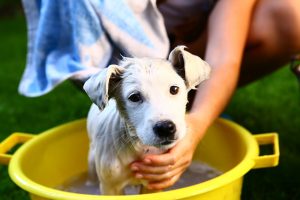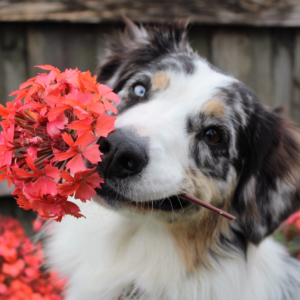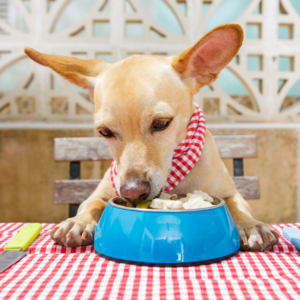 Keeping Dogs Healthy in the Spring and Summer: Spring and summer months are a great time for you and your dog to enjoy the outdoors. However, the spring and summer months can also present unique dangers and health risks for your dog. Here are some dog health care tips that will help ensure that your dog remains safe in the heat.
Keeping Dogs Healthy in the Spring and Summer: Spring and summer months are a great time for you and your dog to enjoy the outdoors. However, the spring and summer months can also present unique dangers and health risks for your dog. Here are some dog health care tips that will help ensure that your dog remains safe in the heat.
In the Spring, check with your veterinarian to see what they recommend in terms of Heartworm Prevention. Heartworm disease is transmitted by mosquitoes and can be fatal. Heartworm disease is truly a silent killer and you can ensure that your dog stays heartworm free with just minimal prevention.
Dog Food:
Spring and summer time is the perfect time to transition your dog to all natural, premium dog food. Transition to the new dog food slowly, by mixing in the new dog food over time. Start by mixing 10% of the new into the old dog food. Add more of the premium dog food every day. Transitioning to a premium, all natural dog food can provide long lasting health benefits for your dog, and may provide them with more energy through the summer months.
Sun Exposure:
Monitor your dog’s tolerance of the direct sun very closely. Never leave your dog out in the sun too long. Dogs can get sunburned just like people. Provide lots of shade for your pet. Dogs can become dehydrated in the sun, so provide plenty of cool, clean water. Older dogs and dogs with thick coats need special attention. Limit their exposure to the heat during hot summer days and exercise them in the morning or evening hours, when temperatures are cooler.
Fleas and Ticks:
Keep your dog free from fleas and ticks during the summer by using all-natural flea and tick treatments. Some of the flea and tick products that are sold over the counter are actually toxic and should be avoided at all costs. Speak with your veterinarian about holistic flea and tick solutions.
Noise:
Protect your dog’s emotional health by avoiding large, noisy events such as rock concerts or fireworks displays. For many dogs, this type of event is stressful and can cause anxiety. Fireworks can be dangerous for humans and pets alike, so never allow your pet to be near fireworks displays. Many pet owners find the Anxiety Wrap effective in helping their pet cope with fireworks and thunder.
Car Rides:
It is extremely dangerous to drive a truck with a dog in the back. In fact, in many states it is illegal. Dogs can be injured from flying debris and can also be thrown from the pick-up bed during the ride. Dogs should always ride in the cab, preferably confined in a crate or by using a seat belt safety harness.
Tags:
Make sure that your dog always wears a dog collar and current dog tags including your phone number. Safety dog collars, such as reflective collars and illuminated dog collars also can keep your dog safe.
Dogs love spring and summer because it means lots of time outdoors. By keeping tabs on your dog’s health, you can make this a fantastic season for you and your dog.
Source: PupLife





 Spring Garden Hazards: As spring arrives and the first buds appear, gardening can be a relaxing and healthy way to pass the time. But it can also pose some potential risks to our cat and dog friends. With care and some knowledge, these risks can be avoided. Here is a list of potential spring garden hazards.
Spring Garden Hazards: As spring arrives and the first buds appear, gardening can be a relaxing and healthy way to pass the time. But it can also pose some potential risks to our cat and dog friends. With care and some knowledge, these risks can be avoided. Here is a list of potential spring garden hazards. Puppy Adoption Guide: Puppy adoption can be the best time of your life and certainly the best time (so far!) of your puppy’s life. But the process isn’t without stress. Questions and uncertainty abound, especially if this is your first time adopting a puppy. What kind of puppy food should you get? Is puppy food actually that different from adult dog food? When should puppy potty training happen, and how do you handle the inevitable messes? What about leash training and socialization? You’ll likely have dozens of questions about puppy adoption, which is why we’ve assembled a number of tips for puppy adoption to help you and your new pal get off on the right…paw.
Puppy Adoption Guide: Puppy adoption can be the best time of your life and certainly the best time (so far!) of your puppy’s life. But the process isn’t without stress. Questions and uncertainty abound, especially if this is your first time adopting a puppy. What kind of puppy food should you get? Is puppy food actually that different from adult dog food? When should puppy potty training happen, and how do you handle the inevitable messes? What about leash training and socialization? You’ll likely have dozens of questions about puppy adoption, which is why we’ve assembled a number of tips for puppy adoption to help you and your new pal get off on the right…paw. Snuffle Mats for Dogs: Dogs love to sniff and explore the world around them. It’s super cute to look at them figuring stuff out! It can be great to encourage this behavior as it helps with their doggy senses. However, sniffing and foraging can cause some issues if they’re pawing at your garden or at your carpets inside. This is where snuffle mats for dogs come in. Read on to find out how they might benefit your dog!
Snuffle Mats for Dogs: Dogs love to sniff and explore the world around them. It’s super cute to look at them figuring stuff out! It can be great to encourage this behavior as it helps with their doggy senses. However, sniffing and foraging can cause some issues if they’re pawing at your garden or at your carpets inside. This is where snuffle mats for dogs come in. Read on to find out how they might benefit your dog! New Year Resolutions for Pets: Tips for enhancing animals’ lives and our own. That’s right, pets can have New Year’s Resolutions too!
New Year Resolutions for Pets: Tips for enhancing animals’ lives and our own. That’s right, pets can have New Year’s Resolutions too!